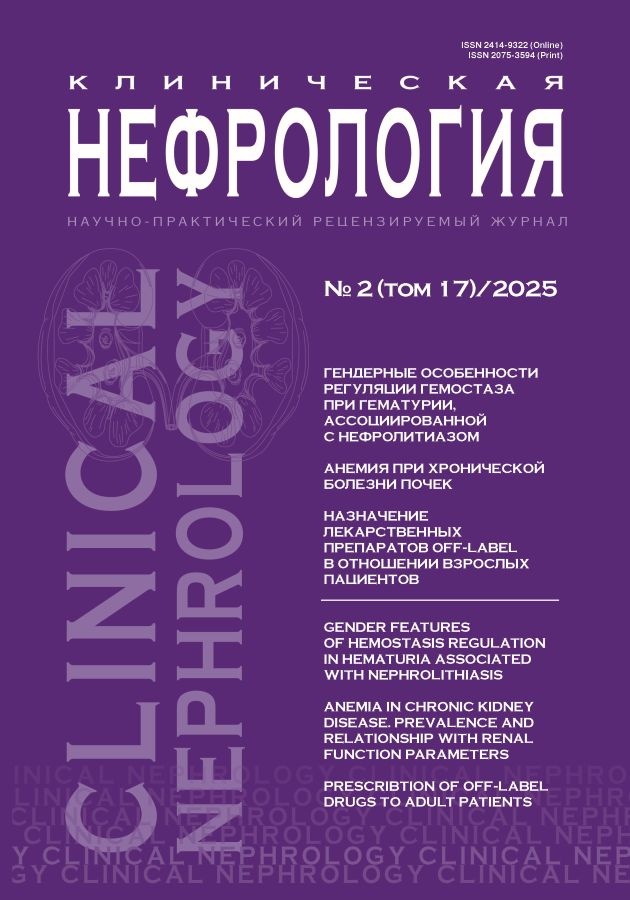Gender features of hemostasis regulation in hematuria associated with nephrolithiasis
- Autores: Barinov E.F.1, Akhundova S.A.1, Giller D.I.1
-
Afiliações:
- M. Gorky Donetsk State Medical University named after
- Edição: Volume 17, Nº 2 (2025)
- Páginas: 6-11
- Seção: Original Articles
- URL: https://journals.eco-vector.com/2075-3594/article/view/692644
- DOI: https://doi.org/10.18565/nephrology.2025.2.6-11
- ID: 692644
Citar
Texto integral
Resumo
Objective. Evaluation of the gender features of the severity of hematuria that occurs during spontaneous elimination of stones from the urinary tract, and to identify receptors that modulate intracellular signaling during the development of compensatory mechanisms of platelet aggregation in women and men.
Material and methods. The study included 89 women (Group 1) and 61 men (Group 2) with nephrolithiasis, in whom hematuria was detected during examination. The activity of receptors regulating proaggregant activity of platelets was analyzed, in particular, purine P2Y-, PX1-receptors, TR-receptor, α2-adrenoreceptor, GPVI-receptor, PAF-receptor, and adenosine A2A-receptor; agonists in concentrations EC50, causing aggregation at the level of 50% in healthy individuals, were used. Modeling of synergism of signaling pathways was reproduced by incubating platelets with subthreshold concentrations of agonists (EC10). Platelet aggregation was assessed by turbidimetric method on the ChronoLog analyzer (USA). Statistical analysis was performed using the MedCalc package.
Results. In the 1st group, severe hematuria (62,0±1,9 RBC per field) developed against the background of hyperreactivity of the PAF receptor and TR receptor, normoreactivity of the α2-adrenoreceptor, purine P2X1 receptor, P2Y receptors, hyporeactivity of the adenosine A2 receptor and GPVI receptor. In the 2nd group, moderate microhematuria (35,9±1,9 RBC per field) was caused by hyperreactivity of the PAF receptor and TR receptor, normoreactivity of purine P2Y receptors, P2X1 receptor, adenosine A2 receptor and GPVI receptor, as well as hyporeactivity of the α2-adrenoreceptor. Limitation of hematuria in the 1st group was ensured by the synergism of the PAF receptor, TR receptor and α2-adrenoreceptor, in the 2nd group - PAF receptor, TR receptor and P2Y receptors. Optimal aggregation parameters in women were achieved through the interaction of signaling pathways associated with Gq and G12/13 (TR receptor) and Gi (α2-adrenoreceptor) proteins; in men - with co-activation of signaling pathways associated with Gq, G12/13 (TR receptor) and Gq, Gi (P2Y receptors) proteins.
Conclusion. Further understanding of the mechanisms of intracellular platelet signaling associated with the GPCR receptor system will optimize the tactics of drug therapy for hematuria associated with nephrolithiasis.
Texto integral
Sobre autores
Eduard Barinov
M. Gorky Donetsk State Medical University named after
Autor responsável pela correspondência
Email: barinov.ef@gmail.com
ORCID ID: 0000-0002-8070-2242
Dr.Sci.(Med.), Professor, Head of the Department of Histology, Cytology, Embryology and Molecular Medicine
Rússia, DonetskSabina Akhundova
M. Gorky Donetsk State Medical University named after
Email: barkova.sabina@bk.ru
ORCID ID: 0009-0001-8400-6500
Senior Lecturer at the Department of Histology, Cytology and Embryology and Molecular Medicine
Rússia, DonetskDina Giller
M. Gorky Donetsk State Medical University named after
Email: dina7670@mail.ru
ORCID ID: 0000-0002-0279-1294
Senior Lecturer at the Department of Histology, Cytology, Embryology and Molecular Medicine
Rússia, DonetskBibliografia
- Liu W., Li G., Shi J. et al. NR4A1 Acts as a Novel Regulator of Platelet Activation and Thrombus Formation. Circ. Res. 2025;136(8):809–26. doi: 10.1161/CIRCRESAHA.124.325645.
- Carazo A., Hrubša M., Konečný L. et al. Sex-Related Differences in Platelet Aggregation: A Literature Review Supplemented with Local Data from a Group of Generally Healthy Individuals. Semin. Thromb. Hemost. 2023;49(5):488–506. doi: 10.1055/s-0042-1756703.
- Zhang L.Q., Che C.X., Du Y.Q. et al. N-homocysteinylation of β-arrestins biases GPCR signaling and promotes platelet activation. Blood. 2025:blood.2024025593. doi: 10.1182/blood.2024025593.
- Rocha G., Sierralta W., Valladares L. [27-Hydroxycholesterol reverses estradiol induced inhibition of platelet aggregation in postmenopausal women]. Rev. Med. Chil. 2016;144(11):1377–81. doi: 10.4067/S0034-98872016001100002. [PMID: 28394953].
- Hall E., Vrolijk M.F. Androgen Receptor and Cardiovascular Disease: A Potential Risk for the Abuse of Supplements Containing Selective Androgen Receptor Modulators. Nutrients. 2023;15(15):3330. doi: 10.3390/nu15153330.
- Haque S.F., Matsubayashi H., Izumi S. Sex difference in platelet aggregation detected by new aggregometry using light scattering. Endocr. J. 2001;48(1): 33–41. doi: 10.1507/endocrj.48.33.
- Man M.Q., Wakefield J.S., Mauro T.M, Elias P.M. Regulatory Role of Nitric Oxide in Cutaneous Inflammation. Inflammation. 2022; 45(3):949–64. doi: 10.1007/s10753-021-01615-8.
- Palur Ramakrishnan A.V., Varghese T.P., Vanapalli S. et al. Platelet activating factor: A potential biomarker in acute coronary syndrome? Cardiovasc. Ther. 2017;35(1):64–70. doi: 10.1111/1755-5922.12233.
- Montecino-Garrido H., Trostchansky A., Espinosa-Parrilla Y. et al. How Protein Depletion Balances Thrombosis and Bleeding Risk in the Context of Platelet’s Activatory and Negative Signaling. Int. J. Mol. Sci. 2024;25(18):10000. doi: 10.3390/ijms251810000.
- Liu S., Anderson P.J., Rajagopal S. et al. G Protein-Coupled Receptors: A Century of Research and Discovery. Circ. Res. 2024;135(1):174–97. doi: 10.1161/CIRCRESAHA.124.323067.
- Soriano Jerez E.M., Gibbins J.M., Hughes C.E. Targeting platelet inhibition receptors for novel therapies: PECAM-1 and G6b-B. Platelets. 2021;32(6): 761–9. doi: 10.1080/09537104.2021.1882668.
- Li Z., Zhang G., Le Breton G.C. et al. Two waves of platelet secretion induced by thromboxane A2 receptor and a critical role for phosphoinositide 3-kinases. J. Biol. Chem. 2003;278(33):30725–31. Doi: 10.1074/ jbc.M301838200.
Arquivos suplementares








